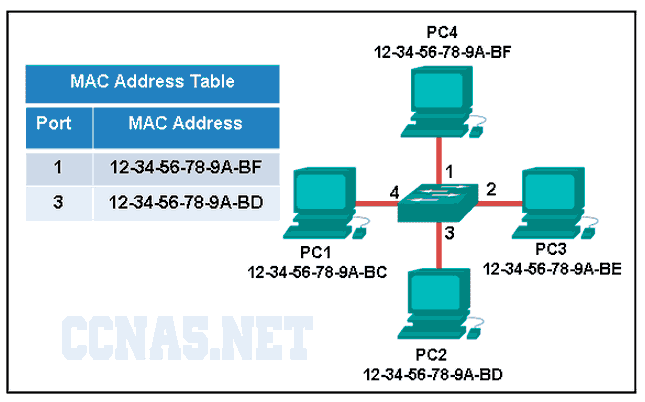CCNA3 v6.0 Chapter 6 Exam Answers
1. When an EIGRP-enabled router uses a password to accept routes from other EIGRP-enabled routers, which mechanism is used?
bounded updates
partial updates
EIGRP authentication*
Diffusing Update Algorithm
Reliable Transport Protocol
2. What is the purpose of using protocol-dependent modules in EIGRP?
to describe different routing processes
to identify different application layer protocols
to use different transport protocols for different packets
to accommodate routing of different network layer protocols*
3. If all router Ethernet interfaces in an EIGRP network are configured with the default EIGRP timers, how long will a router wait by default to receive an EIGRP packet from its neighbor before declaring the neighbor unreachable?
10 seconds
15 seconds*
20 seconds
30 seconds
4. Which statement describes a characteristic of the delivery of EIGRP update packets?
EIGRP uses UDP to send all update packets.
EIGRP sends all update packets via unicast.
EIGRP sends all update packets via multicast.
EIGRP uses a reliable delivery protocol to send all update packets.*
5. Which two EIGRP packet types are sent with unreliable delivery? (Choose two.)
update
query
hello*
reply
acknowledgment*
6. Which destination MAC address is used when a multicast EIGRP packet is encapsulated into an Ethernet frame?
01-00-5E-00-00-09
01-00-5E-00-00-10
01-00-5E-00-00-0A*
01-00-5E-00-00-0B
7. What is identified within the opcode of an EIGRP packet header?
the EIGRP message type that is being sent or received from a neighbor*
the EIGRP autonomous system metrics
the EIGRP hold timer agreed upon with a neighbor
the EIGRP sum of delays from source to destination
8. An administrator issues the router eigrp 100 command on a router. What is the number 100 used for?
as the autonomous system number*
as the number of neighbors supported by this router
as the length of time this router will wait to hear hello packets from a neighbor
as the maximum bandwidth of the fastest interface on the router
9. Why would a network administrator use a wildcard mask in the network command when configuring a router to use EIGRP?
to lower the router overhead
to send a manual summarization
to exclude some interfaces from the EIGRP process*
to subnet at the time of the configuration
10. What information does EIGRP maintain within the routing table?
both successors and feasible successors
only feasible successors
adjacent neighbors
all routes known to the router
only successors*
11. Which table is used by EIGRP to store all routes that are learned from EIGRP neighbors?
the routing table
the neighbor table
the topology table*
the adjacency table
12. Which command or commands must be entered on a serial interface of a Cisco router to restore the bandwidth to the default value of that specific router interface?
bandwidth 1500
shutdown
no shutdown
copy running-config startup-config
reload
no bandwidth*
13. Which three metric weights are set to zero by default when costs in EIGRP are being calculated? (Choose three.)
k1
k2*
k3
k4*
k5*
k6
14. A new network administrator has been asked to verify the metrics that are used by EIGRP on a Cisco device. Which two EIGRP metrics are measured by using static values on a Cisco device? (Choose two.)
bandwidth*
load
reliability
delay*
MTU
15. Refer to the exhibit.
Which two networks contain feasible successors? (Choose two.)
192.168.71.0*
192.168.51.0
10.44.100.252*
10.44.104.253
10.44.101.252
16. A network administrator wants to verify the default delay values for the interfaces on an EIGRP-enabled router. Which command will display these values?
show ip protocols
show running-config
show interfaces*
show ip route
17. Refer to the exhibit.
R3 has two possible paths to the 172.16.99.0 network. What is the reported distance of the feasible successor route?
2340608
2169856
10512128
2816*
18. Refer to the exhibit.
R2 has two possible paths to the 192.168.10.4 network. What would make the alternate route meet the feasibility condition?
a reported distance less than 3523840*
a reported distance greater than 41024000
a feasible distance greater than 41024000
an administrative distance less than 170
19. Which two factors does an EIGRP router use to determine that a route to a remote network meets the feasible condition and is therefore loop-free? (Choose two.)
the successor route on a neighbor router
the feasible successor route on the remote router
the reported distance on a neighbor router*
the administrative distance on the remote router
the feasible distance on the local router*
20. Which configuration is necessary to ensure successful operation of EIGRP for IPv6?
The eigrp router-id command requires an IPv6 address within the router configuration mode.
The network command is required within the router configuration mode.
The no shutdown command is required within the router configuration mode.*
The router eigrp autonomous-system command is required within the router configuration mode.
21. Fill in the Blank. Use the abbreviation.
EIGRP uses the protocol “RTP” to deliver EIGRP packets to neighbors.
22. Fill in the blank.
In an EIGRP topology table, a route that is in a/an “active” state will cause the Diffusing Update Algorithm to send EIGRP queries that ask other routers for a path to this network.
23. Order the precedence in which an EIGRP router would choose the router ID. (Not all options are used.)
24. Match the correct version of EIGRP with the EIGRP features. (Not all options are used.)
25. Open the PT Activity. Perform the tasks in the activity instructions and then answer the question.
Which code is displayed on the web server?
Done
EIGRP
Complete*
IPv6EIGRP
